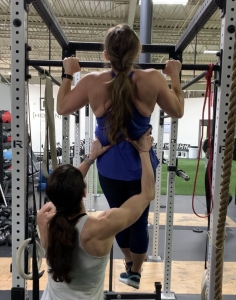Shape your arms for summer! Tips for strong and defined triceps.
The triceps make up for more than 60% of your arm. With that in mind, it’s worth giving them a little extra attention! To give the triceps shape, we need to build muscle. To see that muscle and see definition in the triceps, we need to reduce body fat.
I am a fan of the traditional triceps pushdown. However, I find that the attachment can make a difference in whether you get full extension in the elbow. If the attachment doesn’t allow for this you could be missing out of using the entire triceps. I find this to be the case when using a straight bar or close grip pushdown attachment. As a rule of thumb, if an exercise is worth doing, make the most of it by getting the appropriate range of motion and intensity.
Here are three exercises to maximize triceps engagement…
CABLE CROSS OVER TRICEPS PUSHDOWN
Grip the end of the opposite cable with each hand. Stand with a slight hinge forward. Shoulder blades should be down and arms forward and away from the body. Bend at the elbows and then extend at the elbows to full extension. Pause on the bottom and control cables as you return to the starting position. Avoid swinging shoulders or shrugging.
OVERHEAD EXTENSION WITH STRAP OR ROPE
If you have adjustable cables, set the cable to around waist height. I like a split leg stance on this exercise with a slight lean forward. Grip rope or strap and bring arms overhead. Keep shoulders stable. Bend at the elbows and then extend arms and fully extend. Arms press overhead and apart to get full range of motion.
TRICEPS KICKBACK
Use dumbbells for these. Hinge forward (hips back and back flat) and bring arms close to the body. Straighten your arm and squeeze the triceps. Arms can extend out and away from the body. Avoid swinging arms or going too fast.
These can be done as straight sets or combine them as a tri-set; doing each exercise back to back and then rest. I like a 12-15 rep range for triceps.
Give these a try and let me know what you think!
Outfit by Better Bodies
Use code: VICKI15 for a discount on your order.
To get started with virtual coaching, contact me at My Website


